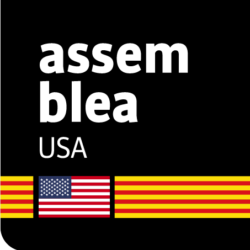Why Independence?
The right of a people to self-determination is a cardinal principle in modern international law. It states that a people, based on respect for the principle of equal rights and fair equality of opportunity, have the right to freely choose their sovereignty and international political status with no interference.
Chapter 1 of The Charter of the United Nation states in Article 1.2 that one of the purposes of the UN is “to develop friendly relations among nations based on respect for the principle of equal rights and self-determination of peoples, and to take other appropriate measures to strengthen universal peace”.
United Nations General Assembly Resolution 1514 from 1960 states in point 2 that: “All peoples have the right to self-determination; by virtue of that right they freely determine their political status and freely pursue their economic, social and cultural development.”
The concept was first expressed in the 1860s, encouraged by United States President Woodrow Wilson. Having announced his Fourteen Points, on 11 February 1918 Wilson stated: “National aspirations must be respected; people may now be dominated and governed only by their own consent. ‘Self-determination’ is not a mere phrase; it is an imperative principle of action.
Nations such as Estonia, Latvia, Kosovo, Slovenia, Quebec in Canada or Scotland have exercised their right to self-determination.
- The arrival of western culture: Greeks and Romans
The Greeks arrived in the territory that today is Catalonia in the 6th century BC. They founded two cities, Rhode (Roses) and Emporion (Empúries), and spread the basis of western culture: that is, their values and their social and political ideas for organizing society. Afterwards, from the 5th to the 3rd century BC, it was the Romans who took over and organized the territory, created infrastructures and established cities such as Tarraco (Tarragone) and Barcino (Barcelona). The importance of the Roman legacy is obvious in many ways. For instance, the Catalan language has its origins in the Latin spoken by Romans, just as Italian, Spanish, French and Portuguese also do.
- The founding of Catalonia
Considered the founder of Catalonia, nobleman Count Guifré el Pilós (Wilfred the Hairy) is a historic figure. He managed to establish a territory between the Pyrenees and the sea, with its capital in Barcelona, at the end of the 9th century. This was the basis of what would be the future sovereign state of Catalonia. In the late 10th century, the Catalan counties stopped transferring taxes to the Frankish kings and, thus, became fully independent.
- Parliamentary tradition
During the 11th century, a primitive form of parliamentary set-up already existed in Catalonia: the Assamblea de Pau i Treva (Peace and Truce Assembly). Formed by peasants and clerics, it aimed to limit the powers of feudal lords. Some years later, in 1283, one of the oldest parliaments in the world was created, Les Corts Catalanes, a deal-making system which prohibited the King from promulgating constitutions or levying general taxes without the authorization of the three estates: the military, the church and nobility. Its mission was, amongst others, to control the King’s tax-related decisions. In order to collect the taxes approved by Les Corts, in 1359 a new institution was created, the Diputació del General, an embryo of the present Generalitat.
- Crown of Aragon: a flourishing maritme power
- Dynastic union between Castile and Aragon
- First Catalan Republic, the War of the Reapers, and the Pyrenees Treaty
- 1714: the end of the Catalan State
- Napoleon and Catalonia
- The recovery of national consciousness: the Renaixença
- Recovering unity: the Mancomunitat
- Macià proclaims the Catalan Republic
- Franco’s military coup and the Spanish Civil War
- A long period of fascist dictatorship
- Transition towards democracy: the Generalitat reinstated
- Time for a new deal
- Statute of Autonomy decimated by Spanish courts and beginning of the conflict for self-determination
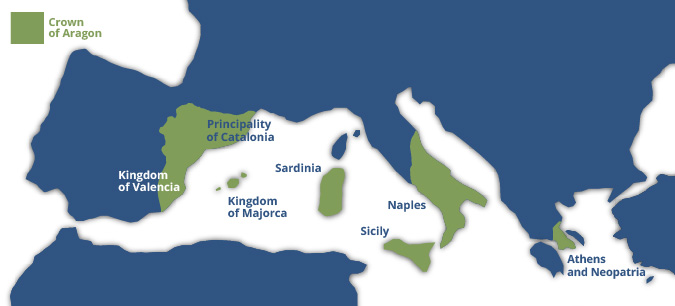
In 1162, Ramon Berenguer IV, Count of Barcelona, married Princess Peronella d’Aragó (Petronilla of Aragon), which led to the creation of the Crown of Aragon. During this period, an assembly known as the General Courts of Catalonia limited the King’s power. Between the 12th and the 15th centuries, the Crown of Aragon expanded its territory through Majorca, Valencia, Sicily, Sardinia, Naples and even Athens. It became a powerful military and commercial empire, which was administrated from Barcelona as a confederation in which each state had its own regulations. The Consulate of the Sea, a pioneering body for the administration of maritime and commercial law, was created. This institution’s documents became the code that ruled transactions in the Mediterranean for many years.
Isabel I de Castella (Isabella of Castile) and Ferran d’Aragó (Ferdinand of Aragon) married in 1469 and united their two realms in a single confederation. The Hispanic monarchs had to swear to respect the rules, constitutions and institutions of Castile and those of the several territories forming the Crown of Aragon.
In 1640 Spanish King Felipe IV (Philip IV) forced Catalan peasants to host his army which was fighting against the French King Louis XIII. The peasants were angry about the treatment they were receiving and rebelled against Philip in the War of the Reapers (Guerra dels Segadors). Some of the most important noblemen ended up in prison. The Generalitat, led by clergyman Pau Claris, established the Catalan Republic, protected by France. It was to be short-lived, though – lasting only a few months. At the same time, Portugal benefited from the uprising and broke away from what we now call Spain. In 1659, the Treaty of the Pyrenees between France and Spain resulted in Philip IV giving part of the Catalan territories – Roussillon, Conflent and part of Cerdagne – to Louis XIV (this is the current French Département des Pyrénées Orientales ).
The War of the Spanish Succession (1701 – 1715) is considered one of the first global war conflicts. Apart from the succession of the Hispanic crown, there was also the question of the balance of power between the different European powers. Within the Hispanic kingdoms, the Crown of Castile supported Felipe de Borbón (Philip de Borbon) while the states of the Crown of Aragon (Principality of Catalonia, Kingdom of Valencia, Kingdom of Aragon and Kingdom of Majorca) aligned with the pretender Charles of Austria, who offered to maintain traditional freedoms. For this reason, the triumph of Philip de Borbon (Philip V of Castile and Aragon IV), heir to French centralism, meant the end of the rights and privileges of the kingdoms of the Crown of Aragon, which were uniformed according to the laws of Castile.
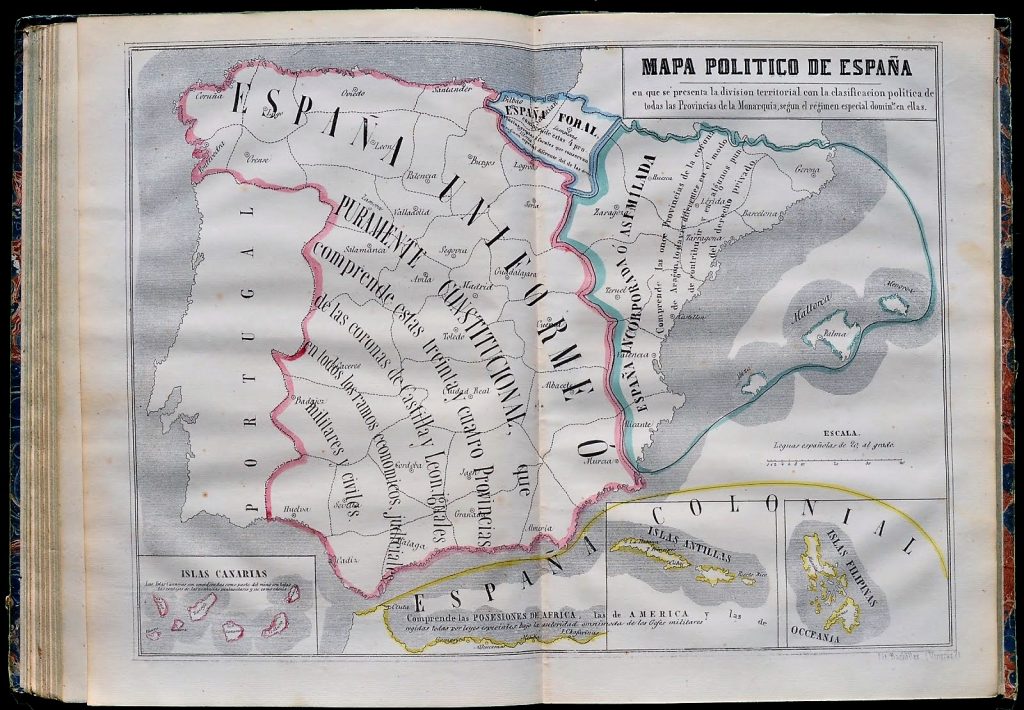

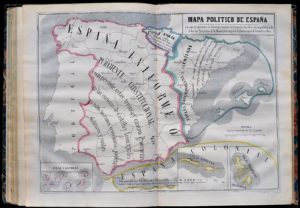
With the fall of Barcelona, on September 11, 1714, Catalonia lost its governing institutions that it had maintained since the Middle Ages. In 1716, with the Nova Planta Decree, the king Philip de Borbon V annulled them legally and subjected Catalonia to the laws of the central power that entailed a great repression against the culture, languages and traditions of the Catalans that continued in reigns and successive dictatorships.
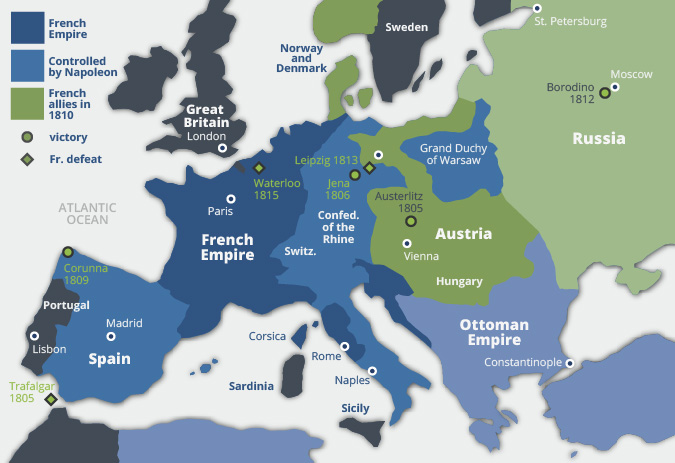
During the Napoleonic Wars, Spanish and French armies fought against each other over several years. At one stage in 1810 Napoleon allowed Catalonia to become an independent Republic under his guardianship. It was a period of sudden about-turns and in 1812 Napoleon incorporated Catalonia as part of his Empire until it became part of the Spanish Kingdom again in 1814 when the French were defeated.
During the 19th century, a cultural movement known as the Renaixença (Rebirth) promoted Catalan language, arts and architecture, with Antoni Gaudí as its most representative figure. Intellectuals, writers and artists took pride in Catalan culture and presented their works in Catalan. Parallel to the Catalan industrial revolution, the Renaixença was one of the boosting motors of Catalanism throughout the 19th century.
At the beginning of the 20th century, Catalonia regained its united administrative system and a certain degree of self-rule. Barcelona’s regional government leader, Enric Prat de la Riba, drove to reinstall a single institution to coordinate decisions among the four Catalan provinces and in 1914 the Mancomunitat was finally established. It was abolished eleven years later by the Spanish dictator Primo de Rivera in 1925.
In 1931, local elections were won by the left-wing republican party Esquerra Republicana de Catalunya (ERC). The leader of the party, Francesc Macià, proclaimed the short-lived Republic of Catalonia. Three days later, he agreed with the newly-born Spanish Republic, the establishment of an autonomous government for Catalonia, under the name of Generalitat. Forced by these circumstances, King Alfonso XIII of Spain had fled into exile.
The Spanish Civil War (July 17, 1936 – April 1, 1939) faced the democratic government of the Second Spanish Republic with a part of the army and with fascist organizations. The war began with a military coup headed by General Francisco Franco on July 17, 1936, which the next day spread throughout the state. The initial defeat of the coup participants in the main industrial centers, in Madrid and in the Mediterranean capitals, gave way to a long and bloody war that killed 500,000 people. It has been estimated that half a million Catalans crossed the French border; some returned, others stayed there, others exiled to Mexico, and many found death in concentration camps or in the new world war that was about to explode. The repression that came to Catalonia with the dictatorship of General Francisco Franco entailed executions, personal and family humiliation, economic plundering and second-class citizens, with duties but without rights. 4,000 Catalans were arbitrarily and systematically executed in Catalonia by the dictatorship.
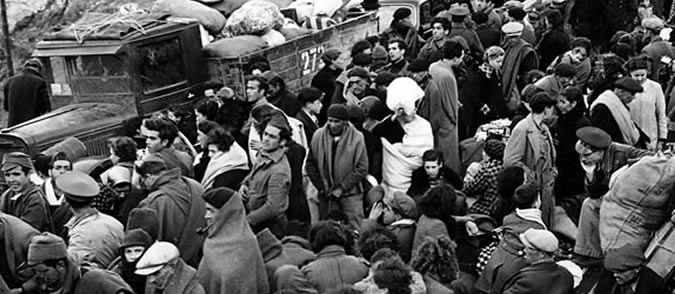
Following the Republican defeat in February 1939, 500,000 people (200,000 of them were Catalans) were forced into exile and many would never come back. Lluís Companys, President of the Catalan Government, was executed in 1940 by firing squad, a unique case among elected presidents in European history. General Francisco Franco imposed a fascist dictatorship that lasted nearly 40 years. He abolished political parties and all democratic rights, such as freedom of speech and freedom of association. In Catalonia, Franco’s regime was especially fierce and he abolished the Statute of Autonomy and the Generalitat. The Catalan language and symbols were forbidden in all public sectors, schools and books.
At the beginning of the 1970s, calls for democracy and self-rule among groups of workers and students were on the increase. However, Franco’s dictatorship showed it was not open to change. Activists were sentenced to death and executed – as happened in the case of Catalan anarchist Salvador Puig Antich in 1974. The dictatorship finally came to an end with Franco’s death in 1975. During the following transition period, Catalan civil society mobilised to make its voice heard – in 1977 the first demonstration after Franco’s death was huge, with more than one million people marching through the streets of Barcelona and asking for freedom, amnesty and a new Statute of Autonomy. Before the new Spanish Constitution was passed, Josep Tarradellas, the President of the Generalitat elected in exile, returned to Catalonia on 23 October 1977. He reinstalled the Generalitat and set up an interim government. The Statute of Autonomy was promulgated on 18 September 1979.
Ever since the restoration of democracy in Spain and the devolution of limited self-rule to Catalonia, the main Catalan political parties have always been supportive of any efforts to consolidate democracy and to socially and economically modernize the Spanish State. Their involvement in Spain’s governance was evident with their support for different minority governments in Madrid, especially, when faced with big challenges like the accession to the EU or to the Euro. In 2004, when Spain’s democracy was seen as fully consolidated and the country was featured as one of the EU’s best examples of social and economic success, 90% of the MPs of the Catalan Parliament proposed to reform its Statute of Autonomy so as to consolidate Catalonia’s self-rule and finally find a suitable place for Catalonia within the Spanish State. The lack of a proper answer from the largest Spanish political parties to this proposal is probably the main reason why nowadays many Catalans are asking for a new deal.
In 2010 Spain’s Constitutional Court issued a landmark ruling that inadvertently laid the ground for Sunday’s independence referendum in Catalonia. At issue was the 2006 Statute of Autonomy of Catalonia, a law passed by the legislature in the autonomous Spanish community, that was then approved by Spain’s parliament and later ratified in a referendum by Catalan voters. Almost immediately, the Popular Party, the center-right group that now governs the country, challenged the statute (parliament was then dominated by the Socialists) before the Constitutional Court. The court, Spain’s highest body for matters related to the constitutionality of laws, deliberated for the next four years. And its June 28 decision, on the face of it at the time, seemed harmless enough: Of the statute’s 223 articles, the court struck down 14 and curtailed another 27. Among other things, the ruling struck down attempts to place the distinctive Catalan language above Spanish in the region; ruled as unconstitutional regional powers over courts and judges; and said: “The interpretation of the references to ‘Catalonia as a nation’ and to ‘the national reality of Catalonia’ in the preamble of the Statute of Autonomy of Catalonia have no legal effect.”
Catalonia has one of the oldest parliamentary traditions in Europe. During the 11th century, a primitive form of parliamentary system already existed in Catalonia: the Assembly of Peace and Truce. Formed by peasants and clerics, it aimed to limit the powers of feudal lords. Some years later, in 1283, one of the earliest parliament was created, Les Corts Catalanes, a deal-making system that prohibited the King from promulgating constitutions or levying general taxes without the authorization of the three estates: the military, the church and nobility.
This parliamentary, democratic and consensual tradition has always guided Catalonia when trying to solve the problem of its political relationship with Spain. The solution that the Government of Catalonia has repeatedly proposed to the Spanish Government since 2012 is that of a binding referendum in accordance with international legislation and the United Nations. It has always been rejected.
Catalonia started in 2012 an independence process (commonly referred as ‘the process’) as a way to gain independence through a binding referendum.
Catalonia has repeatedly tried to find common ground with Spain since in 1714 lost its rights. Many Catalans believe it is no longer possible and they see the Catalan Republic as the way to guarantee their political and civil rights. The problem has been aggravated in the last year with unjustified repression and police violence on the occasion of the October 1 referendum and with the imprisonment of Catalan civil and political leaders.
Catalan is Catalonia’s own language. In the 9th century, it had evolved from Latin and belongs to the branch of Romance languages such as French, Portuguese, Italian or Spanish. Catalan, Occitan (spoken in the Val d’Aran valley) and Spanish are official languages in Catalonia.
Catalan is spoken in an area of more than 68,000 km2 in four different states: Andorra, Spain (Catalonia, Valencia, the Balearic Islands and eastern Aragon), France (northern Catalonia) and Italy (in the city of Alghero in Sardinia) .
About 10 million people speak Catalan actively and about 12 million understand it. It is the 9th most spoken language in the European Union.
2% of the EU population speaks or knows Catalan, more than Danish, Finnish, Lithuanian, Slovene, Estonian, Irish, Latvian, and Maltese. In spite of this, Catalan is not official in the EU due to the opposition of Spain.
With Franco’s dictatorship, Catalan was absolutely prohibited in educational, official and public scopes. That is why there are whole generations that have not enjoyed schooling in Catalan have trouble in writing it. In the 1980’s, after Franco’s death, Catalan was reinstated as the main language of the Catalan educational system with “linguistic immersion” methodology.
With the linguistic immersion every person (children and adults) has a total access to learning Catalan and Spanish As a result no one can be discriminated against for language reasons, and language serves as a basic tool for communication as well as a tool for social cohesion.
The Catalan language immersion model is a case study for educational communities around the world, except for Spain where it is periodically and systematically put to debate based on prejudices without any scientific basis.
Since 1988, Catalonia has been one of the 4 Motors of Europe; along with the German land of Baden-Württemberg, the Italian Lombardy and the French region of Auvergne-Rhone-Alps.
For a long time, Catalonia has headed the ranking of Spanish regions in terms of their share of Spain’s GDP. Currently, Catalan contribution is 19% of the total Spanish GDP, followed by the Community of Madrid.
According to Spain’s treasury figures, Catalonia’s fiscal deficit (difference between the money sent to Madrid and the money it receives back and is spent in Catalonia) reached 16.570 billion euros in 2014, equivalent to 8.4% of its GDP, according to a 2018 study published by the Catalan Government. Catalonia contributed to 19.5% of the revenues of the Central Administration and the Social Security and received only 14% of the Central Administration and Social Security expenditures (Catalan population is 16% of Spanish population; Catalan GDP is 18,9% of Spanish GDP). Excluding Social Security payments Catalonia contributed to 19.7% of the Central Administration revenues and received only 11.1% of the Central Administration expenditures. This means that the return of each euro paid in taxes to the central government is 56 cents. Of each euro paid 44 cents are not spent in Catalonia.
If a more restrictive criteria is employed (i.e. the benefit approach that considers that central ministries expenditures located in Madrid benefits equally all regions in Spain), Catalonia’s fiscal deficit was 11,590 billion euros in 2014. That is 5.9% of the gross domestic product (GDP).
In Spain, these fiscal flows cannot be attributed exclusively to a redistribution policy. There are rich regions that do not show fiscal deficit (Basque Country and Navarre); there are rich regions such as Aragon, Cantabria and la Rioja, that have a fiscal surplus (i.e. they receive net transfers). And finally, poor regions (with a GDP lower than average) have a fiscal deficit. The regional financing system, a system that overequalizes, and central government investment’s policy are mainly responsible for these results
The Catalan economy grew by 3.4% in 2017, just one tenth less than in 2016 and 2015. Thus, Catalan GDP growth stands three tenths above the whole of Spain and exceeds the euro zone average by one point. The results of the last three years (3.5% in 2015, 3.5% in 2016 and 3.4% in 2017), together with the results registered in 2014 (2.3%), represent a period of strong growth for the Catalan economy.
Many foreign companies have seen in Catalonia and especially Barcelona, the perfect place to settle in order to have a presence in southern Europe. At present, there are 8,642, with at least 50% of foreign capital, from 89 different countries, with Germany, France and the United States as the top investing countries. Catalonia is by far Spain’s top export region, with a quarter of all goods produced there sold abroad in 2016 and in the first quarter of 2017. It attracted about 14 percent of foreign investment in Spain in 2015.
Since 1986, with the integration to the EU market, as well as with world trade liberalization, the importance of the Spanish market for Catalonia has been reduced. In 2017, with an export record of 70,828 bilion euros, sales to foreign markets accounted for 64.5% of total external sales, while sales to Spain represented only 35.5%. Catalan exports represent 25.6% of total Spanish exports.
Catalonia, an exporting economy, would need a public investment complementary to its exporting industry, to favour the competitiveness of its firms in a globalising world. Yet, central government has systematically discriminated projects such as the rail freight transport connection with France and the improvement of the Mediterranean axis in favour of projects that interest political elites of the central government and give votes in the less dynamic regions.
The case of Catalonia in Spain is a good case study of the economic forces that shape the creation and break up of nations. The equilibrium of these forces has changed due to globalization and the development of regional blocs. Centripetal forces, pulling heterogeneous territories together, have weakened; and centrifugal forces, pushing towards disintegration, have been reinforced. In the case of Catalonia, the regional redistribution system is a key factor that would explain the growing dissatisfaction of the Catalan population but political and cultural issues are also very important.
Since the late 1990’s, both the conflicts of competences, the insufficient financing and the new challenges that the Catalan language and culture face in a globalizing world, have led to an increasing claim for independence. The failure in the implementation of the new Statute of Autonomy has been a key element for the electoral success of the independence movement.
There have been several moments in history when Catalonia has welcomed people from all over the world and we want it to continue happening.
In Catalonia, we believe diversity is essential for a rich and critical thinking society when it comes to making, sharing, living together and, above all, learning from each other on how to make a better society.
Many Catalans feel that Spain does not allow them to develop the social policies that the Parliament of Catalonia approves. Laws referring to energy poverty, climate change, gender equality, universal health, audio-visual tax and the welcoming of refugees have been systematically repealed by the Spanish courts of justice.
Sports, music, gastronomy, painting, literature… Catalonia stands out in different activities, from the most disciplinary to the most creative ones; it the result of this sense and fury (seny i rauxa) that are built in the Catalan character.
Names such as Kilian Jornet, Pep Guardiola, Mireia Belmonte, Xavi Hernández, Laia Sanz, Pau and Marc Gasol, Ona Carbonell, Ricky Rubio, Carles Puyol, Gemma Mengual, Marc Márquez, Pol and Aleix Espargaró and Dani Pedrosa excel in disciplines such as climbing, soccer, motorcycling, basketball and swimming; most of them are world champions. They are all just a sample of all the sporting talent that exists in Catalonia.
On the other hand, the sensitivity of Pau Casals with his cello and his commitment to the country during the civil postwar period, from exile, is an asset for all who live and work in Catalonia.
Dalí, Miró, Casas, Tàpias and Picasso they are all artists that were imbued with the Catalan creativity. Each one interpreted reality from Catalonia, be either through surrealism, abstract, dada, modernism or avant-garde.
Creativity also shows in the culinary arena. Many of the top restaurants in the world are in Catalonia: the Adrià brothers, the Roca brothers and Carme Ruscalleda, are among the world renowned Catalan chefs.
Every identity consists of several cultural traditions. Some have even crossed borders and are known beyond the Catalan countries. Sant Jordi, the book and the rose festival; Castanyada, the Catalan rendition of Haloween (much sweeter by the way); the Caga-tió, a trunk that for Christmas eats and brings children gifts when they hit it. And what about the Castellers, human towers 5 story tall built by as many as 300 people that are World Heritage. A metaphor of Catalonia, no doubt.

